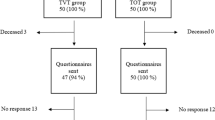Abstract
Purpose: To determine the efficacy of tension-free vaginal tape (TVT) for the treatment of five sub-types of stress urinary incontinence (SUI).
Materials and methods: A retrospective review was performed from November 1998 to November 2001 on all patients with SUI who underwent a TVT procedure either alone or with other reconstructive pelvic procedures. The patients were subdivided into five categories. Intrinsic sphincter deficiency (ISD) was defined by a maximum urethral closure pressure <20 cm H2O or a mean Valsalva leak point pressure <60 cm H2O above baseline. Urethral hypermobility (UH) was defined by a straining Q-tip angle greater than 30° from the horizontal. Cure was defined as the subjective resolution of SUI without the development of voiding dysfunction or de novo urge incontinence. Improvement was defined as the subjective improvement of SUI without complete resolution or the subjective resolution of SUI occurring with the development of prolonged voiding dysfunction lasting greater than 6 weeks or de novo urge incontinence. Failure was defined as the subjective lack of improvement of SUI, the need for an additional procedure to correct SUI or the need for revision or takedown of the TVT for persistent voiding dysfunction or mesh erosion.
Results: The cure, improvement and failure rates for each of the following groups are respectively as follows: group 1 (+UH, -ISD) (n=121): 101 (83.5%), 13 (10.7%), 7 (5.8%); group 2 (-UH, +ISD) (n=22): 17 (77.3%), 3 (13.6%), 2 (9.1%); group 3 (+UH, +ISD) (n=32): 26 (81.3%), 4 (12.5%), 2 (6.2%); group 4 (-UH, -ISD) (n=25): 21 (84.0%), 3 (12.0%), 1 (4.0%); group 5 (occult SUI) (n=67): 57 (85.1%), 10 (14.9%), 0 (0%).
Conclusion: This study shows that the TVT is effective in treating all five sub-types of SUI.
Similar content being viewed by others
References
McGuire EJ, Lytton B, Pepe V et al (1976) Stress incontinence. Obstet Gynecol 47:255–264
Blaivas JG, Olsson CA (1988) Stress incontinence: classification and surgical approach. J Urol 139:727–731
Ulmsten U, Henriksson P, Johnson P et al (1996) An ambulatory surgical approach under local anesthesia for treatment of female urinary incontinence. Int Urogynecol J 7:81–86
Nilsson CG, Kuuva N, Falconer C, et al (2001) Long-term results of the tension-free vaginal (TVT) procedure for surgical treatment of female stress urinary incontinence. Int Urogynecol J 2(Suppl):S5–S8
Rezapour M, Falconer C, Ulmsten U (2001) Tension-free vaginal tape (TVT) in stress incontinent women with intrinsic sphincter deficiency (ISD)—a long-term follow-up. Int Urogynecol J 2(Suppl):S12–S14
Mutone N, Brizendine E, Hale D (2003) Clinical outcome of tension-free vaginal tape procedure for stress urinary incontinence without preoperative urethral hypermobility. J Pelvic Med Surg 9:75–81
Karram MM (2003) Pathophysiology of genuine stress incontinence: what do we really know? Int Urogynecol J 14:77
Uebersax JS, Wyman JF, Shumaker SA et al (1995) Short forms to assess life quality and symptom distress for urinary incontinence in women: the Incontinence Impact Questionnaire and the Urogenital Distress Inventory. Neurourol Urodyn 14:131–139
Ulmsten U, Johnson P, Rezapour M (1999) A three-year follow up of tension free vaginal tape for surgical treatment of female stress urinary incontinence. Br J Obstet Gynaecol 106:345–350
Kleeman S, Goldwasser S, Vassallo B et al (2002) Predicting voiding efficiency after surgery for incontinence and prolapse. Am J Obstet Gynecol 187(1):49–52
Grody MH (1998) Urinary incontinence and concomitant prolapse. Clin Obstet Gynecol 41:777–785
Bakas P, Liapis A, Creatsas G (2002) Q-tip test and tension-free vaginal tape in the management of female patients with genuine stress incontinence. Gynecol Obstet Invest 53:170–173
Klutke JJ, Carlin BI, Klutke CG (2000). The tension-free vaginal tape procedure: correction of stress incontinence with minimal alteration in proximal urethral mobility. Urology 55:512–514
Kayigil O, Ahmed S, Metin A (1999). The coexistence of intrinsic sphincter deficiency with type II stress incontinence. J Urol 162:1365–1366
Gordon D, Gold RS, Pauzner D et al (2001). Combined genitourinary prolapse repair and prophylactic tension-free vaginal tape in women with severe prolapse and occult stress urinary incontinence: preliminary results. Urology 58:547–549
Author information
Authors and Affiliations
Corresponding author
Rights and permissions
About this article
Cite this article
Segal, J.L., Vassallo, B.J., Kleeman, S.D. et al. The efficacy of the tension-free vaginal tape in the treatment of five subtypes of stress urinary incontinence. Int Urogynecol J 17, 120–124 (2006). https://doi.org/10.1007/s00192-005-1371-9
Received:
Accepted:
Published:
Issue Date:
DOI: https://doi.org/10.1007/s00192-005-1371-9




